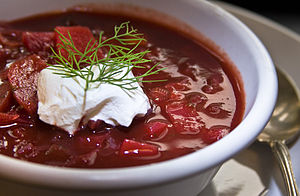BORSCHT

A bowl of borscht garnished with dill and a dollop of smetana (sour cream)
|
|
| Alternative names | Borsch, borshch, borsht, bortsch |
|---|---|
| Type | Soup |
| Place of origin | Ukraine |
| Associated national cuisine | Various East European cuisines |
| Cooking time | 3 hours to 6 hours |
| Serving temperature | Hot or cold |
| Main ingredients | Beetroot |
| Variations |
Green borscht, white borscht |
Borscht (English pronunciation: ![]() i/ˈbɔːrʃ, bɔːrʃt/) is a sour soup popular in several Eastern European cuisines, including Ukrainian, Russian, Polish, Belarusian, Lithuanian, Romanian, and Ashkenazi Jewish cuisines. The variety most commonly associated with the name in English is of Ukrainian origin and includes beetroots as one of the main ingredients, which gives the dish a distinctive red color. It shares the name, however, with a wide selection of sour-tasting soups without beetroots, such as sorrel-based green borscht, rye-based white borscht and cabbage borscht.
i/ˈbɔːrʃ, bɔːrʃt/) is a sour soup popular in several Eastern European cuisines, including Ukrainian, Russian, Polish, Belarusian, Lithuanian, Romanian, and Ashkenazi Jewish cuisines. The variety most commonly associated with the name in English is of Ukrainian origin and includes beetroots as one of the main ingredients, which gives the dish a distinctive red color. It shares the name, however, with a wide selection of sour-tasting soups without beetroots, such as sorrel-based green borscht, rye-based white borscht and cabbage borscht.
Borscht derives from an ancient soup originally cooked from pickled stems, leaves and umbels of common hogweed, a herbaceous plant growing in damp meadows, which lent the dish its Slavic name. With time, it evolved into a diverse array of tart soups, among which the beet-based red borscht has become the most popular. It is typically made by combining meat or bone with sautéed vegetables, which – as well as beetroots – usually include cabbage, carrots, onions, potatoes and tomatoes. Depending on the recipe, borscht may include meat or fish, or be purely vegetarian; it may be served either hot or cold; and it may range from a hearty one-pot meal to a clear broth or a smooth drink. It is often served with smetana or sour cream, hard-boiled eggs or potatoes, but there exists an ample choice of more involved garnishes and side dishes, such as uszka or pampushky, that can be served with the soup.
...
Wikipedia
